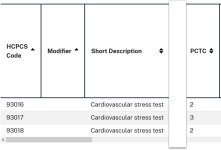Hoping someone has some insight into nuclear stress tests. I am really confused on knowing when to code 93017, in my facility it is usually paired with 93016. It states tracing only. The only thing I can think to match it up with in documentation is the administration of A9502 because when I look up Tetrofosmin it states it is a tracer. Any guidance?
You're confounding the terms “tracing” and “tracer”.
Tracing refers to the
electrocardiogram tracing. “The ECG represents a graphic recording of the electrical cardiac activity
traced on the electrocardiograph paper.”[
1] The ECG tracing can be viewed on paper and/or electronically.
Tracer refers to a
radionuclide tracer, such as Myoview (Technetium tetrofosmin) or Cardiolite (Technetium sestamibi), administered during a cardiac stress test for myocardial perfusion imaging (MPI).
We need to know exactly what you mean by facility. Is your facility owned by a physician who also performs the supervision, interpretation, and report?
Let’s assume your facility is a hospital (POS 22). This means that your hospital (facility) cannot report the global 93015. Hence, this is the reason you (your facility) are reporting 93016, 93017, etc.
 CMS Physician Fee Schedule - PCTC Indicators for 93016-93018
CMS Physician Fee Schedule - PCTC Indicators for 93016-93018
93016 has a PCTC indicator of 2, meaning that it is a professional component only code. A facility, such as a hospital in which a stress test is performed, cannot submit a claim for 93016. Only
the physician who supervises the stress test can submit a claim for 93016.
93017 has a PCTC indicator of 3, meaning that it is a technical component only code. A facility, such as a hospital in which a stress test is performed, can submit a claim for 93017. Only
the facility can submit a claim for 93017.
93018 has a PCTC indicator of 2, meaning that it is a professional component only code. A facility, such as a hospital in which a stress test is performed, cannot submit a claim for 93018. Only
the physician who interprets and reports the stress test can submit a claim for 93018.
In summary, your facility can only submit a claim for
93017. Assuming the ECG equipment produced an ECG tracing during the stress test, and that ECG tracing has been captured and stored electronically in the patient's health record, that is sufficient to code 93017.
Per AAPC,[
2]
93017 (… tracing only, without interpretation and report). This code presents the technical component of the cardiac stress test. Report code 93017 for the ECG tracing only. This component includes technicians, providing the cardiac stress test equipment, paying for the rental space, utilities, and supplies.
Also,
When your cardiologist performs a cardiac stress test in a facility setting, for example, a hospital, the hospital will report the technical component of the stress test, and the physician will report the applicable component codes — either 93016, 93018, or both codes, according to CPT® Assistant. Make sure that your physician just reports the component of the stress test that they actually performed.
There is often associated imaging (e.g., MPI) performed during a cardiac stress test, so there would be other codes associated with that imaging that the facility could submit claims for (at least the technical component (TC)). You can also submit claims for the pharmaceuticals used during the stress test.
==================================================================================================
Footnotes
[1]
https://www.ncbi.nlm.nih.gov/books/NBK549803/
[2]
https://www.aapc.com/codes/coding-n...our-cardiac-stress-test-coding-174820-article